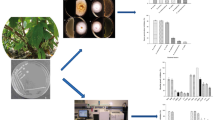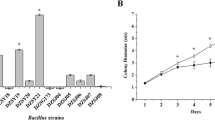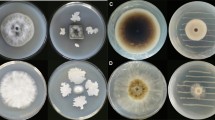Abstract
Volatile organic compounds (VOCs) produced by bacteria have significant potential to control phytopathogens. In this study, the VOCs produced by endofungal bacteria Pseudomonas sp. Bi1, Bacillus sp. De3, Pantoea sp. Ma3 and Pseudomonas sp. De1 isolated from wild growing mushrooms were evaluated in vitro for their antagonistic activity against Pseudomonas tolaasii Pt18, the causal agent of mushroom brown blotch disease. The gas chromatography–mass spectrometry (GC–MS) analysis revealed that strains Pseudomonas sp. Bi1, Pseudomonas sp. De1, Bacillus sp. De3 and Pantoea sp. Ma3 produced eight, sixteen, nine, and twelve VOCs, respectively. All antagonistic endofungal bacteria produced VOCs which significantly reduced brown blotch symptoms on mushroom caps and inhibited the growth of P. tolaasii Pt18 at the varying levels. Scanning electron microscopy revealed severe morphological changes in cells of P. tolaasii Pt18 following exposure to the VOCs of Pseudomonas sp. Bi1 and De1. Furthermore, The VOCs produced by endofungal bacteria significantly reduced swarming, swimming, twitching, chemotaxis motility and biofilm formation by P. tolaasii Pt18 cells, which are essential contributors to pathogenicity. This is to first report about the inhibition effects of VOCs produced by antagonistic bacteria on virulence traits of P. tolaasii. Our findings provide new insights regarding the potential of antibacterial VOCs as a safe fumigant to control mushroom brown blotch disease.





Similar content being viewed by others
References
Aslani MA, Harighi B, Abdollahzadeh J (2018) Screening of endofungal bacteria isolated from wild growing mushrooms as potential biological control agents against brown blotch and internal stipe necrosis diseases of Agaricus bisporus. Biol Control 119:20–26
Audrain B, Farag MA, Ryu CM, Ghigo JM (2015) Role of bacterial volatile compounds in bacterial biology. FEMS Microbiol Rev 39:222–233
Begum IF, Mohankumar R, Jeevan M, Ramani K (2016) GC–MS analysis of bio-active molecules derived from Paracoccus pantotrophus FMR19 and the antimicrobial activity against bacterial pathogens and MDROs. Indian J Microbiol 56:426–432
Castiblanco LF, Sundin GW (2016) New insights on molecular regulation of biofilm formation in plant-associated bacteria. J Integr Plant Biol 58:362–372
Cole ALJ, Skellerup MV (1986) Ultrastructure of the interaction of Agaricus bisporus and Pseudomonas tolaasii. Trans Br Mycol Soc 87:314–316
Dandurishvili N, Toklikishvili N, Ovadis M, Eliashvili P, Giorgobiani N, Keshelava R, Tediashvili M, Vainstein A, Khmel I, Szegedi E, Chemin L (2011) Broad-range antagonistic rhizobacteria Pseudomonas fluorescens and Serratia plymuthica suppress Agrobacterium crown gall tumors on tomato plants. J Appl Microbiol 110:341–352
Fernando WGD, Ramarathnam R, Krishnamoorthy AS, Savchuk SC (2005) Identification and use of potential bacterial organic antifungal volatiles in biocontrol. Soil Biol Biochem 37:955–964
Fletcher JT, Gaze RH (2007) Mushroom pest and disease control: a colour handbook. CRC Press, Boca Raton
Ghasemi S, Harighi B, Azizi A, Mojarrab M (2020) Reduction of brown blotch disease and tyrosinase activity in Agaricus bisporus infected by Pseudomonas tolaasii upon treatment with endofungal bacteria. Physiol Mol Plant Pathol 110:101474
Grewal SIS, Rainey PB (1991) Phenotypic variation of Pseudomonas putida and P. tolaasii affects the chemotactic response to Agaricus bisporus mycelial exudate. J Gen Microbiol 137:2761–2768
King EO, Ward K, Raney S, Raney DE (1954) Two simple media for the demonstration of pyocyanin and fluorescin. J Lab Clin Med 44:301–307
Koç AN, Silici S, Mutlu-Sariguzel F, Sagdic O (2007) Antifungal activity of propolis in four different fruit juices. Food Technol Biotechnol 45:57–61
Malcolm HD (1981) A toxin associated with bacterial blotch of mushrooms. Mushroom Sci 11:324–330
Minerdi D, Bossi S, Gullino ML, Garibaldi A (2009) Volatile organic compounds: a potential direct long distance mechanism for antagonistic action of Fusarium oxysporum strain MSA 35. Environ Microbiol 11:844–854
Nair NG, Fahy PC (1972) Bacteria antagonistic to Pseudomonas tolaasii and their control of brown blotch of the cultivated mushroom Agaricus bisporus. J Appl Bacteriol 35:439–442
Olivier JM, Guillau JS, Martin D (1978) Study of a bacterial disease of mushroom caps. In: Proceedings of the 4th international conference on plant pathogenic bacteria, INRA, Angers, France, pp 903–916
Osdaghi E, Martins SJ, Ramos-Sepulveda L, Vieira FR, Pecchia JA, Beyer DM, Bell TH, Yang Y, Hockett KL, Bull CT (2019) 100 years since tolaas: bacterial blotch of mushrooms in the 21st century. Plant Dis 103:2714–2732
O’Toole GA, Kolter R (1998) Initiation of biofilm formation in Pseudomonas fluorescens WCS365 proceeds via multiple, convergent signaling pathways: a genetic analysis. Mol Microbiol 28:449–461
Park HB, Lee J, Kloepper WB, Ryu CM (2013) Exposure of Arabidopsis to hexadecane, a long chain volatile organic compound, confers induced resistance against both Pectobacterium carotovorum and Pseudomonas syringae. Plant Signal Behav 8:e24619
Rainey PB (1991) Phenotypic variation of Pseudomonas putida and P. tolaasii affects attachment to Agaricus bisporus mycelium. J Gen Microbiol 137:2769–2779
Rainey PB, Brodey CL, Johnstone K (1991) Biological properties and spectrum of activity of tolaasin, a lipodepsipeptide toxin produced by the mushroom pathogen Pseudomonas tolaasii. Physiol Mol Plant Pathol 39:57–70
Rajer FU, Wu H, Xie Y, Xie S, Raza W, Tahir HAS, Gao X (2017) Volatile organic compounds produced by a soil-isolate, Bacillus subtilis FA26 induce adverse ultra-structural changes to the cells of Clavibacter michiganensis ssp. sepedonicus, the causal agent of bacterial ring rot of potato. Microbiology 163:523–530
Raza W, Ling N, Liu D, Wei Z, Huang Q, Shen Q (2016a) Volatile organic compounds produced by Pseudomonas fluorescens WR-1 restrict the growth and virulence traits of Ralstonia solanacearum. Microbiol Res 192:103–113
Raza W, Ling N, Yang L, Huang Q, Shen Q (2016b) Response of tomato wilt pathogen Ralstonia solanacearum to the volatile organic compounds produced by a biocontrol strain Bacillus amyloliquefaciens SQR-9. Sci Rep 6:24856
Samson R, Houdeau G, Khanna P, Guillaumes J, Olivier JM (1987) Variability of fluorescent Pseudomonas populations in composts and casing soils used for mushroom cultures. Dev Crop Sci 10:19–26
Sandin M, Allenmark S, Edebo L (1990) Selective toxicity of alkanolamines. Antimicrob Agents Chemother 34:491–493
Saxon EB, Jackson RW, Bhumbra S, Smith T, Sockett RE (2014) Bdellovibrio bacteriovorus HD100 guards against Pseudomonas tolaasii brown-blotch lesions on the surface of post-harvest Agaricus bisporus supermarket mushrooms. BMC Microbiol 14:163
Schmidt R, Cordovez V, de Boer W, Raaijmakers J, Garbeva P (2015) Volatile affairs in microbial interactions. ISME J 9:2329–2335
Schulz S, Dickschat JS (2007) Bacterial volatiles: the smell of small organisms. Nat Prod Rep 24:814–842
Shirata A (1996) Production of volatile components by Pseudomonas tolaasii and their toxic activity. Ann Phytopathol Soc Jpn 62:185–193
Soler-Rivas C, Jolivet S, Arpin N, Olivier JM, Wichers HJ (1999) Biochemical and physiological aspects of brown blotch disease of Agaricus bisporus. FEMS Microbiol Rev 23:591–614
Tahir HAS, Gu Q, Wu H, Niu Y, Huo R, Gao X (2017) Bacillus volatiles adversely affect the physiology and ultra-structure of Ralstonia solanacearum and induce systemic resistance in tobacco against bacterial wilt. Sci Rep 7:40481
Tilocca B, Cao A, Migheli Q (2020) Scent of a killer: microbial volatilome and its role in the biological control of plant pathogens. Front Microbiol 11:41
Tsukamoto T, Murata H, Shirata A (2002) Identification of non-pseudomonad bacteria from fruit bodies of wild agaricales fungi that detoxify tolaasin produced by Pseudomonas tolaasii. Biosci Biotechnol Biochem 66:2201–2208
Wong WC, Preece TF (1982) Pseudomonas tolaasii in cultivated mushroom (Agaricus bisporus) crops: numbers of the bacterium and symptom development on mushrooms grown in various environments after artificial inoculation. J Appl Bacteriol 53:87–96
Xie A, Zang H, Wu H, Rajer FU, Gao X (2018) Antibacterial effects of volatiles produced by Bacillus D13 against Xanthomonas oryzae pv. oryzae. Mol Plant Pathol 19:49–58
Yuan J, Raza W, Shen Q, Huang Q (2012) Antifungal activity of Bacillus amyloliquefaciens NJN-6 volatile compounds against Fusarium oxysporum f. sp. cubense. Appl Environ Microbiol 78:5942–5944
Zarenejad F, Yakhchali B, Rasooli I (2012) Evaluation of indigenous potent mushroom growth promoting bacteria (MGPB) on Agaricus bisporus production. World J Microbiol Biotechnol 28:99–104
Zhang X, Li B, Wang Y, Guo Q, Lu X, Li S, Ma P (2013) Lipopeptides, a novel protein, and volatile compounds contribute to the antifungal activity of the biocontrol agent Bacillus atrophaeus CAB-1. Appl Microbiol Biotechnol 97:9525–9534
Acknowledgements
This research work was supported by The University of Kurdistan, Iran.
Author information
Authors and Affiliations
Contributions
All authors have been personally and actively involved in substantive work leading to the manuscript.
Corresponding author
Ethics declarations
Conflict of interest
The authors declare that they have no conflict of interest.
Research involving human and animal participants
This research does not involved human participants and animals.
Additional information
Handling Editor: Jane Debode.
Rights and permissions
About this article
Cite this article
Ghasemi, S., Harighi, B., Mojarrab, M. et al. Response of Pseudomonas tolaasii, the causal agent of mushroom brown blotch disease to the volatile compounds produced by endofungal bacteria. BioControl 66, 421–432 (2021). https://doi.org/10.1007/s10526-020-10071-6
Received:
Accepted:
Published:
Issue Date:
DOI: https://doi.org/10.1007/s10526-020-10071-6




